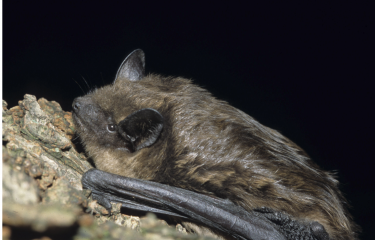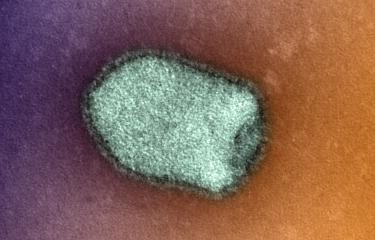The largest active surveillance study of rabies in bats ever performed was carried out by researchers from the Institut Pasteur and from the University of Barcelona in Spain. This study, published in 'PLoS ONE', enabled the evaluation of the dynamics of the infection in its animal reservoirs and had useful implications for public health. The study also confirmed a limited but still real risk of transmission of the rabies virus from bats to humans.
Press release
Paris, june 27, 2007
Rabies, a systemic disease that is fatal if not treated, causes some 50,000 deaths, most often following infection transmitted by a rabid dog. Various domestic and wild animals can transmit the lyssavirus that causes the disease in bats. The latter is actually the origin of rare cases in humans: four confirmed cases of rabies following a bat bite have been recorded since 1985 in Finland, Scotland, Ukraine, and Russia.
There are about 1,000 species of bats, representing about 20% of all mammal species, and they play host to a multitude of viruses that is still very much unknown. The bats serve as the reservoirs for a number of emerging viruses (Ebola, Hendra, Nipah, etc) and are therefore of interest to those who want to study the viruses that infect the bats more closely.
That is the objective of the study that was recently carried out by the Lyssavirus Dynamics and Host Adaptation Unit, directed by Hervé Bourhy, at the Institut Pasteur and Jordi Serra-Cobo's team from the Animal Biology Department at the University of Barcelona in Spain.
Two cohorts of insect bats from the species Myotis myotis, totalling more than 800 animals, were followed over a period of 12 years on Spain's Balearic Islands. Using capture, mark, and recapture methods along with sampling and banding, and thanks to the use of mathematical models and modelling for this particular pursuit, the researchers were able to understand the dynamics of infection by lyssavirus in these animals.
They demonstrated that the infections survived through dormant periods, for which the period varied in time as a function of the rate at which individuals presented humoral immunity. They were able to calculate the time -- 5 days on average -- during which an infected bat transmits the virus. Finally, they demonstrated that infection by lyssaviruses does not cause death in bats, as opposed to that which survives in terrestrial animal reservoirs of rabies (foxes, dogs, etc).
"This point is very important in public health terms, in so far as the infection does not cause strong changes in the comportment of these animals in the same way that it does in, say, dogs, emphasised Hervé Bourhy. In addition, even though we confirm the potential risk of transmission of lyssavirus in the bat to humans, we also show that, at least for the species that were studied, the risk is limited in time and it does not persist. The dynamic of the infection in the bat that was revealed by our study has confirmed the decision taken in Europe to protect these animals and to not destroy the colonies in which there is rabies. The only reasonable measure now is to restrict access to the caves where bats that are susceptible to infection live. "
Today, Hervé Bourhy's team, in collaboration with another team from the Institut Pasteur and the team from The University of Barcelona aims to study the mechanisms that can lead to an explosion of lyssavirus infection in the bat colonies. She is also co-coordinator, with the Institut Pasteur at Tunis, for the European RABMEDCONTROL program, which comprises a plan for the study of bats that consists of the analysis of migration routes for animals between Africa and Europe across the various different points of the study (Spain, Morocco, Tunisia, Sicily Calabre in Italy, and Egypt) and the parallel circulation of the lyssavirus. The goal of this program is to understand the epidemiology of this virus.
Remember, killing, capturing, transporting, and selling bats are strictly forbidden in France and in Europe, and no attempt should be made to catch a sick nor should a dead bat be touched. It is highly recommended that anyone who is bitten, scratched, or licked by a bat immediately consult with an anti-rabies centre. According to Hervé Bourhy, who is also in charge of the National Rabies Reference Center, "Nonetheless, it must be emphasised that the risk in France comes essentially from animals (cats, monkeys) that have been illegally imported". Here one is reminded of the episode that took place in the summer of 2004, when a puppy imported from Morocco caused a rabies alert in French territory.
Sources
" Temporal dynamics of european bat lyssavirus type 1 and survival of Myotis myotis bats in natural colonies " : PLoS ONE, 27 juin 2007.
Blanca Amengual (1,2), Hervé Bourhy (1), Marc Lòpez-Roig (2) et Jordi Serra-Cobo (2)
1. Applicant Unit for Expert Research in the Dynamics of Lyssavirus and its Adaptation to the Host
2. Animal Biology Department, University of Barcelona, Barcelona, Spain
myotispresse%20copie
Bats Myotis myotis © Hervé Bourhy/ Institut Pasteur
Contact persons
Institut Pasteur Press Department :
Nadine Peyrolo or Corinne Jamma
Tel : 33 (0) 1 40 61 33 41
cjamma@pasteur.fr
Mobilisation Against the Reemergence of Rabies: The Instituts Pasteur work with the European Union
The kick-off for RABMEDCONTROL, the great project for the fight against rabies financed by the European Union, was given to the Institut Pasteur in Tunis in September of 2006. This project, financed at more than 1.1 million euros for three years, is coordinated by the Instituts Pasteur in Tunis and in Paris. It involved many research, public health, and veterinary units in three countries in Southwest Europe and four countries in North Africa. Four institutes from the International Network of Instituts Pasteur participate in the program.
The goal of the RABMEDCONTROL program is to eradicate rabies in North Africa, where the disease is responsible for several hundred human deaths each year. The concerned laboratories have entered an epidemiological study of the disease in its North Africa endemics for the purposes of establishing the epidemiological and social reasons that explain why the disease persists in these countries despite all of the efforts that have been made. The European program also analyses the routes that allow the virus to reach the Mediterranean coasts of Europe, studying the impact of the illegal importation of domestic carnivores, especially dogs, and the bat species that live on the two Mediterranean rivers and can serve as vectors and reservoirs for the virus.
This entire body of data will in the end allow proposals on effective strategies for the elimination of this terrible disease from North Africa to be made to health authorities.
Participating libraries:
Institut Pasteur, Paris, France
Institut Pasteur of Tunis, Tunisia
Institut Pasteur of Algiers, Algeria
Biopharma Laboratory, Morocco
Regional Laboratory for Veterinary Analysis and Research at Casablanca, Morocco
Institut Pasteur of Casablanca, Morocco
University of Barcelona, Barcelona, Spain
The French Food Safety Agency (AFSSA, Agence Française de Sécurité Sanitaire des Aliments), Malzeville, France
Instituto de Salud Carlos III, Madrid, Spain
Instituto Zooprofilattico Sperimentale delle Venezie, Legnaro, Italy
Faculty of Veterinary Science, Egypt
Website: www.rabmedcontrol.org




